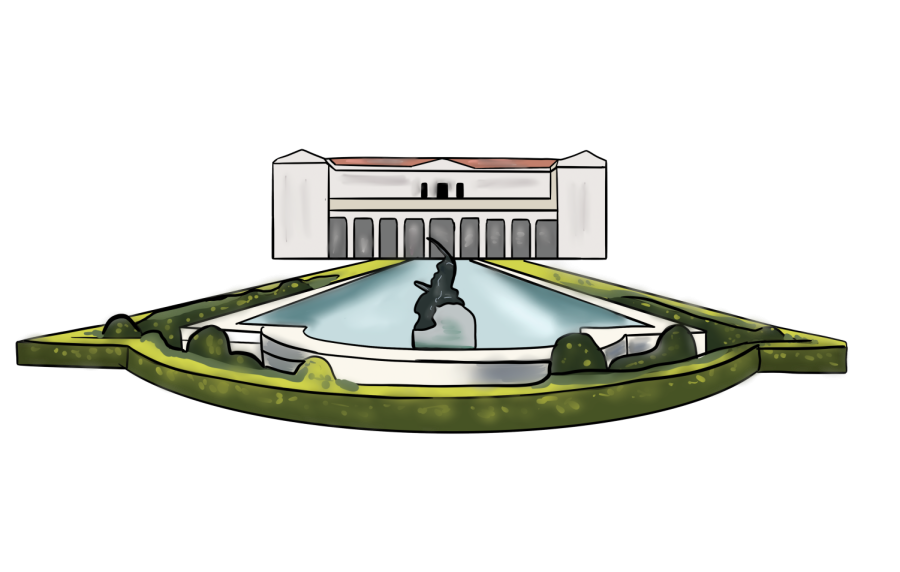Time for Culture
Illustration by Alexa Druyanoff
Visual Arts Teacher Conor Thompson visits New York City and enters the Metropolitan Museum of Art.
February 17, 2022
When Visual Arts Teacher Conor Thompson visits New York City, he said he enters the Metropolitan Museum of Art with a specific work of art in mind. Once, he focused on Dutch Baroque painter Johannes Vermeer’s “Young Woman with a Water Pitcher.” Standing in front of the creamy oil colors of the painting, he said his method of looking at art helps him take in its full impact and feeling.
“I am a painter, and I learn so much by going out and looking carefully at the work of artists in museums,” Thompson said. “So much art we look at now is online, and I love the experience of seeing art in person. I try to slow myself down and sit with the painting for 15 minutes or more, giving myself time to notice subtleties of detail, light and form.”
Thompson said he often visited the Isabella Stewart Gardner Museum and the Museum of Fine Arts, Boston as a high school student in New England. Thompson said observing different works of art inspired him to become a painter.
“I had romantic notions about being an artist, and spending time in museums fed into my fantasies and inspired me to take art seriously,” Thompson said. “For students, I think it comes down to having the experience of seeing the art in person. If you look at something as a [presentation] slide in your art history class, you don’t get the full impact of the piece. You can understand art intellectually, but you haven’t really experienced it unless you go to see it in person.”
Harper Fogelson ’24 said she enjoys visiting museums especially to see classical and Renaissance art because it gives her unique insight into various historical periods.
“I enjoy going to art museums, especially those with ancient Greek or Roman art,” Fogelson said. “I find the sculptures to be really intriguing, [and] I think it’s interesting to see an image from the past. It’s very different from just [written primary sources] because you can visualize [an image] and step into the artist’s mind.”
Fogelson said although she prefers sculpture, she also appreciates other art mediums displayed in museums.
“I love all paintings, but mostly those that are not modern,” Fogelson said. “I think [Leonardo da Vinci’s work] is spectacular, and I love Claude Monet’s ‘Woman With a Parasol.’ There was an image of it in my preschool, so I became fascinated with it.”
Eva Salas ’22 said she visits museums as often as possible, usually with friends, to enrich her study of art history and socialize.
“Being able to see the works and movements that I study in [Honors Art History] is super helpful and satisfying,” Salas said. “Talking to friends about the pieces in context is a lot of fun and it’s so exciting to see works that you recognize. Visiting museums is also a great chance for calm and quiet time both alone and with friends, which I treasure.”
Salas said she appreciates the large selection of museums and other cultural sights located in Los Angeles.
“Los Angeles has a particularly fantastic selection of museums which are all definitely worth a visit, but I especially love the Getty Villa Musuem, The Norton Simon Museum and The Broad,” Salas said. “I’m also a big fan of [The Huntington Library, Art Museum and Botanical Gardens], but more so for the gardens [than the museum].”
Asher Rossen ’23 said he appreciates the educational opportunities museums provide by directly showing visitors a piece of artwork or a scientific concept.
“When I go to museums, I love the ones with fossils, living creatures and other representations of animals, like the La Brea Tar Pits,” Rossen said. “You learn so much about the subject that the museum is teaching about because, oftentimes, there are visual representations that not only help you see history but also help you become more interested in or help you feel connected to the subject at hand.”
History Teacher Katharine Holmes-Chuba said for her, visiting museums is a calming and grounding experience.
“We are surrounded by such bad news that when going to museums and galleries I am awed by the dedication and vision of the artists,” Holmes- Chuba said. “I find it inspiring and uplifting. As I have gotten older, I have gotten better at using my time, so I will go to a museum for a specific purpose, but if I am visiting a city I know I will never visit again, I will spend hours in a museum.”
Holmes-Chuba said the quality and quantity of LA’s museums is often underappreciated by students. The city is home to over one hundred museums, according to Discover Los Angeles.
“Sometimes, students don’t realize what a culturally rich city we live in,” Holmes-Chuba said. We have world class museums and galleries. Also, the museums have done a really good job with tackling diversity and inclusivity, broadening their scope in their shows.”
Holmes- Chuba said visiting a museum could prompt a student to learn or experience something new.
“Going to museums and operas are ways to educate yourself outside of school,” Holmes-Chuba said. “Art is a window to the past, so you can look at portraits or still lifes in a different century’s mindset, which is fascinating.”































